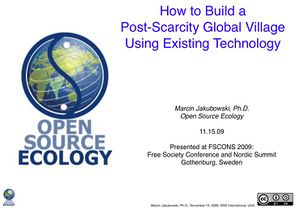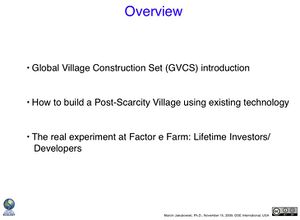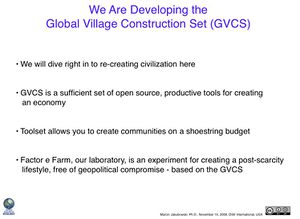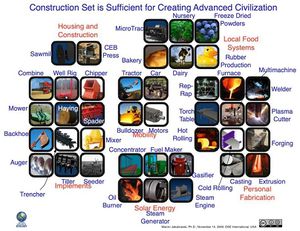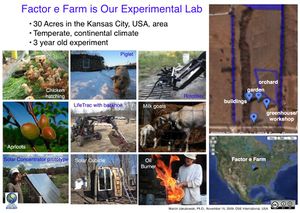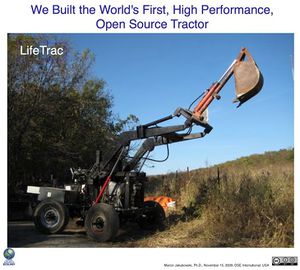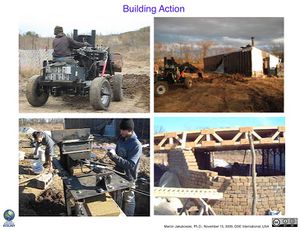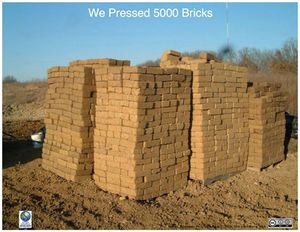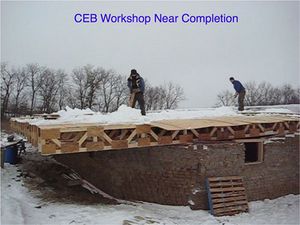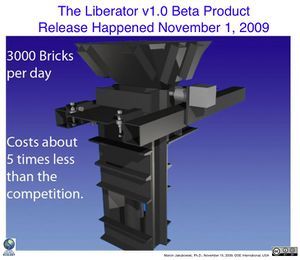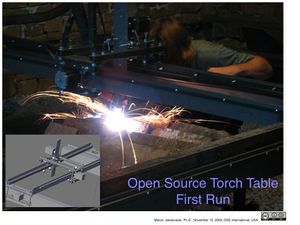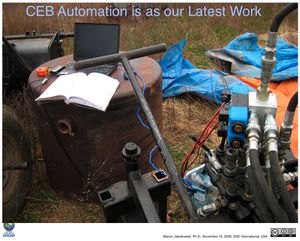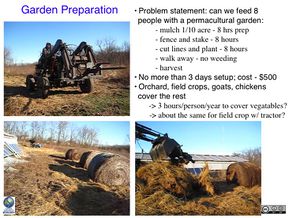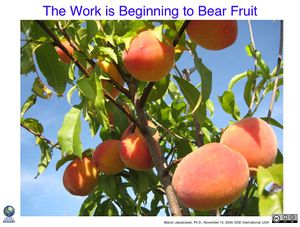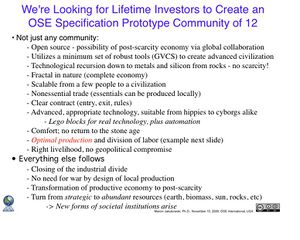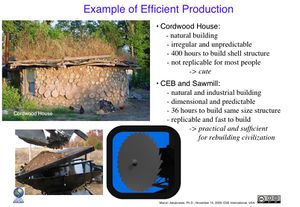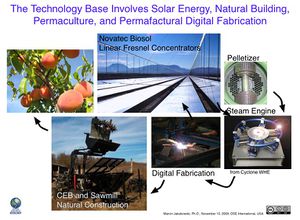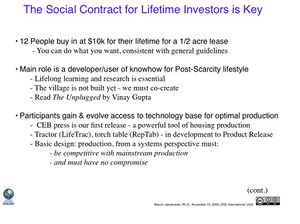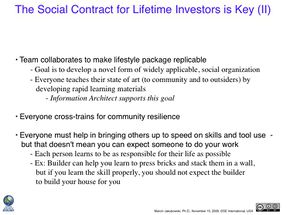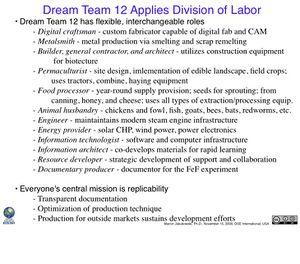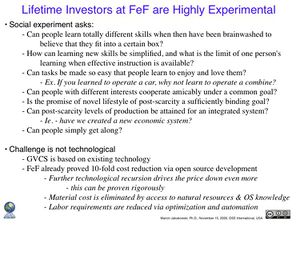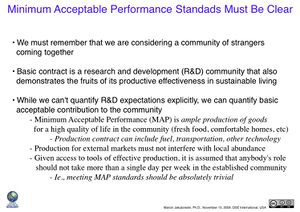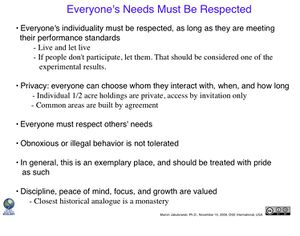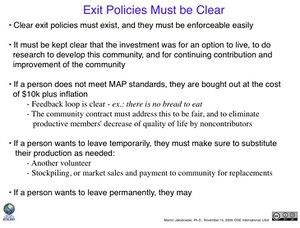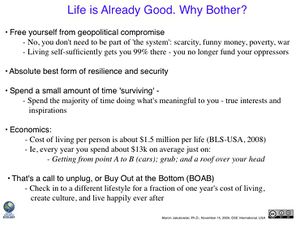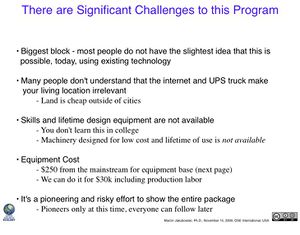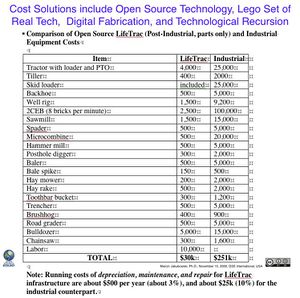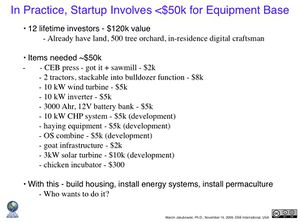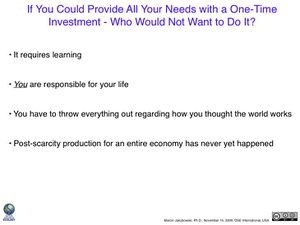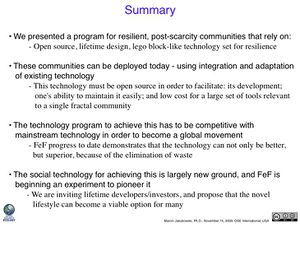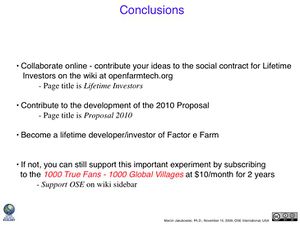FSCONS 2009 Slides: Difference between revisions
m (→Slide 17) |
|||
| Line 179: | Line 179: | ||
<html> | <html> | ||
<object width="400" height="300"><param name="allowfullscreen" value="true" /><param name="allowscriptaccess" value="always" /><param name="movie" value="http://vimeo.com/moogaloop.swf?clip_id=7575628&server=vimeo.com&show_title=1&show_byline=1&show_portrait=0&color=&fullscreen=1" /><embed src="http://vimeo.com/moogaloop.swf?clip_id=7575628&server=vimeo.com&show_title=1&show_byline=1&show_portrait=0&color=&fullscreen=1" type="application/x-shockwave-flash" allowfullscreen="true" allowscriptaccess="always" width="400" height="300"></embed></object><p><a href="http://vimeo.com/7575628">Bale Munching with Soil Pulverizer</a> from <a href="http://vimeo.com/user2016419">Marcin Jakubowski</a> on <a href="http://vimeo.com">Vimeo</a>.</p> | |||
</html> | </html> | ||
Revision as of 17:44, 12 November 2009
Slide 1
The title of our presentation is How to Build a Post-Scarcity Village Using Existing Technology. My name is Marcin, originally from Poland, now based in the USA, Kansas City area. My background is a Ph.D. in physics in fusion energy, and I want a refund for my schooling, because I have since discovered that my schooling did not prepare me in any way for what was to come ahead.
We’ve got an interesting socio-technological experiment going on – on building the world’s first, replicable, post-scarcity, resilient community – or real people living on land, using their local resources. The key is open source collaboration to develop the place, and to reduce cost and skill barriers to make such a place replicable.
The title for this talk was originally Transformative Economics via Open Source Product Development – but that was rather abstract, and we have a very practical experiment on the ground. We are really building a post-scarcity village by means of open source development, so I’d like to focus on this as a clear, underlying theme. What we mean by this post scarcity village will become clear as the presentation progresses, and if it isn’t, we will have 45 minutes after this 45 minute talk for further discussion. Please note your questions and save them for the end, as the complexity of the subject makes that desirable, and the whole picture may emerge more clearly as the talk progresses.
Slide 2
The basic theme of a post-scarcity village is distributive production – production that tends to distribute benefit not to the few, but to as many as possible – consistent with concepts of Jeffersonian democracy. To this end, we are building an open source product development center as part of our post-scarcity village. We have defined a basic set of insfrastructure tools that can get us through survival, and onto a good footing for thriving – as the process of production becomes optimized, and therefore, trivial to accomplish. We are using existing technology – but opensourcing it – to build the foundation of a resilient community – and to deliver on the promise of technology to serve human needs – not humans serving the needs of technology. We have already obtained encouraging results on open product development, the most noteworthy of which is the product release of our first product – the high performance, open source, Compressed Earth Brick (CEB) press. With these initial results, we are beginning to talk seriously about design and build of a real community – one that delivers on unprecedented quality of life – but without geopolitical compromise. We are looking for lifetime codeveloper/investors to make this happen. We are to date funded entirely by crowd donations, and we publish all results openly.
Slide 3
is our experiment for creating a post-scarcity lifestyle, free of inherent participation in geopolitical compromise - killing, stealing, war, dumbing down of the population, etc.
Slide 4
Here is the hardware set. This set of hardware is minimal, and we propose that you can accomplish about 99% of the things you need to live and thrive with this set. It does not include turning rock into metal (advanced civilization) or turning rock into silicon (digital age) - but it does cover your food, shelter, energy, transportation, and most of your technology needs. We're talking about basics here, plus, with digital fabrication - or computer controlled fabrication fueled by a global repository of design (just coming into existence) - we can go down to creating other tools and components that complete the set to other areas including turning plants into fuels or turning rocks into metals and into silicon as mentioned.
Slide 5
Allow me to explain the technology set a little more, and how it applies to building a post-scarcity village from scratch. This 5-minute video begings to explain this process, and it represents the on-the-ground work, merely begun, going on at Factor e Farm (FeF).
How to Build a Post-Scarcity Village from Marcin Jakubowski on Vimeo.
Slide 6
Factor e Farm is our physical laboratory. It is a hackspace of a different flavor - one where a community is being built from the earth and plants and around - by applying open source information to transform this earth and plants into the substance of surviving and thriving.
.
Slide 7
Some things we do are building open source tractors,though the feedstock is industrial metal.
.
Slide 8
Here we are doing initial testing on the tractor.
.
Slide 9
We build using the open source compressed earth block press which we designed and built. It's our first Product Release.
.
Slide 10
Here is a pile of 5000 bricks that we pressed last year.
.
Slide 11
We used them to build our workshop addition.
.
Slide 12
The high performance, open source CEB press is now in production - our first product release. You can buy one for $3500 if you are one of our True Fans, and $5500 if you are not. True Fans are supporters of our work - through the 1000 True Fans - 1000 Global Villages campaign, who agree to support us at $10/month for 2 years.
The press has produced 6 bricks per minute with manual controls, and now we're working on automation and optimization. We think we can get 12 bricks per minute with the automatic version.
Slide 13
You can look on our blog for more information on the initial field testing results, then the addition of the soil shaker, and [and announcement of product release.
.
Slide 14
We also did initial testing of the computer controlled torch table, which will be featured in Make Magazine in January.
.
Slide 15
Our present work is CEB automation. We are using an Arduino microcontroller, connected to solenoid valves. We have gotten up to 7 bricks per minute so far, but the existing valves cannot handle the power output of LifeTrac - so the next steps is larger valves.
.
Slide 16
We are also preparing garden beds for next year. It consists of 1/10 acre covered with about 7000 lb of straw mulch - or almost 4, large, round bales. The experiment is important - as we claim that with proper preparation - it should take about 6 hours per person per year, for an 8 person team - to privide a 100% year round access to fresh food - if one has the appropriate equipment. It's about technique and equipment if one wants to do this without effort.
The plan is quite simple and elegant - we'll report on the results after next year. We're 5 hours into that 48 hour experiment.
.
Slide 17
This 30 second video shows how more powerful equipment can assist human effort in the above task. We are using our soil pulverizer to pulverize bales.
Bale Munching with Soil Pulverizer from Marcin Jakubowski on Vimeo.
